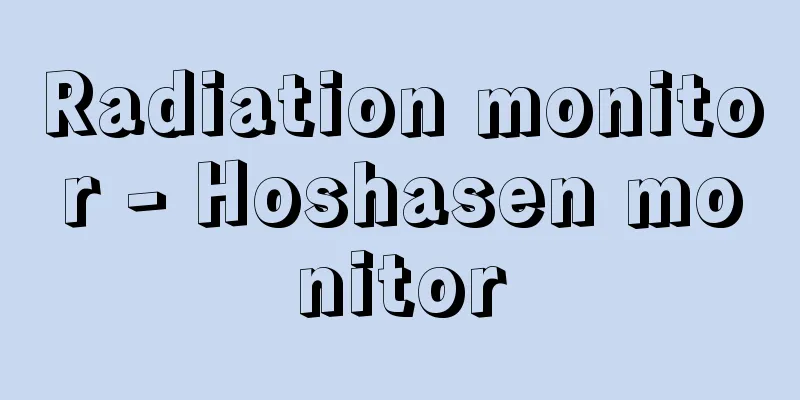Radiation monitor - Hoshasen monitor

|
Radiation monitoring is not only used to ensure the safety of nuclear power and radiation work, but also to measure the environmental radiation levels and contamination levels of radioactive materials in the work environment, the surrounding environment of the facility, the ocean and soil, and to link them to radiation protection measures, such as in work to deal with crisis situations under radiation contamination due to nuclear power plant accidents, and in oceans and soil contaminated by large amounts of radiation. Radiation monitors are used to monitor the radiation dose and contamination levels. Measurement and evaluation of the exposure dose of radiation workers and individuals engaged in crisis response under radiation contamination is also monitoring. In normal work environments, area monitors fixed in the facility and survey meters carried by workers are used. These include monitors for radioactive contamination, air and dust monitors in the facility, and hand-foot-cloth monitors to check for contamination of hands and feet. In the surrounding environment, environmental monitors, exhaust and wastewater monitors, etc. are used. Area monitors and survey meters use ionization chambers, Geiger-Muller counters, scintillation counters, etc. as detectors, and display the dose rate. Radiation monitors in the work environment must be able to respond quickly to changes in the radiation field, so they have a short time constant. The purpose of monitoring the environment around the facility is to observe long-term changes in radiation and radioactivity, and since low-level measurements are targeted, highly sensitive measuring devices such as scintillation counters are used. Thermoluminescence dosimeters are used for this purpose. It goes without saying that monitors for measuring the radiation dose of radiation workers and workers themselves in contaminated environments must be small and lightweight. Small and lightweight alarm monitors (alarm dosimeters) are used, which emit an alarm sound and flash a light when a preset dose is reached. In the critical situation caused by the Fukushima Daiichi nuclear accident in March 2011, various radiation monitors and the assurance of verification accuracy of radiation monitoring are essential for people who may be exposed to radiation, from workers involved in accident containment and decontamination to residents in a wide area. Source : Heibonsha Encyclopedia About MyPedia Information |
|
原子力や放射線作業の安全確保のみならず,原発事故などによる放射線汚染下の危機的状況に対処する作業,さらには,大量の放射線によって汚染された海洋や土壌など,作業環境や施設周辺環境,海洋や土壌の環境放射線レベルや放射性物質による汚染レベルを測定し,放射線防護上の処置に結びつけることを放射線モニタリングといい,放射線量のレベル,汚染レベルのモニタリングに用いる測定器が放射線モニターである。放射線作業者や放射線汚染下での危機対処に従事する個人の被曝線量の測定評価もモニタリングである。通常の作業環境では,施設内に固定したエリアモニター,作業者が携行するサーベイ・メーターが用いられる。放射能による汚染のモニター,施設内の空気やダストモニターあるいは手足の汚染をチェックするハンドフットクロスモニターなどがある。周辺環境では,環境モニター,排気・排水のモニターなどが用いられる。エリアモニターやサーベイ・メーターは,電離箱,ガイガー=ミュラー計数管,シンチレーションカウンターなどを検出器として用い,線量率で表示する。作業環境の放射線モニターは,放射線場の変化にすばやく応答できることが必要で,時定数を短くしている。施設周辺環境のモニターには,長期にわたる放射線や放射能の変化をみることを目的としており,低レベルの測定が対象となるので,シンチレーションカウンターなど高感度の測定器が用いられている。この目的には熱ルミネセンス線量計などが用いられている。放射線作業者や汚染下での作業者自身の被曝線量の測定のためのモニターは小型軽量であることが必須であるのはいうまでもない。小型軽量であることが必須で,アラームモニター(警報線量計)というあらかじめセットした線量に達すると警報音を発し,光が点滅する小型モニターが使われる。2011年3月に起こった福島第一原発の大事故による危機的状況で,事故収束や除染にかかわる作業者から広域の住民まで,被曝の可能性のある人々にとって,多様な放射線モニターと放射線モニタリングの検証精度の確保が不可欠のものとなっている。
出典 株式会社平凡社百科事典マイペディアについて 情報 |
<<: Radiation dose - hoshasenryo
>>: Radiation sterilization - hoshasenmekin (English spelling) radiation sterilization
Recommend
RSA - RSA
A public key cryptography algorithm developed in 1...
Otomo no Sukunamarō - Otomo no Sukunamarō
Years of birth: unknown. An official in the early ...
The Beginning of the Korean Classical Chinese Text - The Beginning of the Korean Classical Chinese Text
Kabuki Kyogen. Historical piece. 4 acts. Commonly ...
Kakokai - Kakokai
One of the nationalistic revolutionary groups tha...
Yaroslav
Grand Prince of Kievan Rus (reigned 1019-1054). He...
La condition humaine (English)
...He further increased his literary fame with Th...
Rakugetsudo Soushi
?-? A comic writer in the mid-Edo period. During ...
Illumination
...an epistemological principle asserted especial...
Salt spring - Enruisen
〘 noun 〙 A hot spring that contains a lot of chlor...
Carr, Edward Hallett
Born: June 28, 1892, London [Died] November 3, 198...
Nail clipper
…In the Meiji period, specially made grip scissor...
Hirano Shrine
It is located in Hiranomiya Honmachi, Kita Ward, ...
Tout - Kakuhiki
[noun] (suru) The act of calling out to customers ...
Blue rice cake
...A sticky rubber-like substance found mainly in...
Mathematics - mathematics
Mathematics is the study of numbers, quantities, ...









